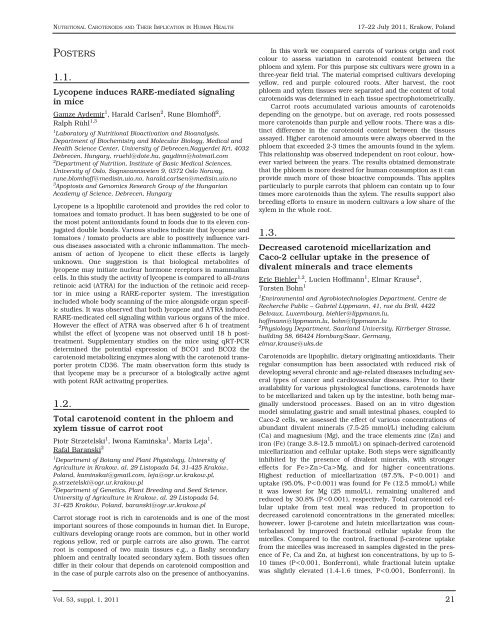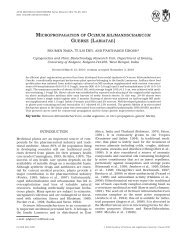ACTA BIOLOGICA CRACOVIENSIA
ACTA BIOLOGICA CRACOVIENSIA
ACTA BIOLOGICA CRACOVIENSIA
You also want an ePaper? Increase the reach of your titles
YUMPU automatically turns print PDFs into web optimized ePapers that Google loves.
NUTRITIONAL CAROTENOIDS AND THEIR IMPLICATION IN HUMAN HEALTH<br />
POSTERS<br />
1.1.<br />
Lycopene induces RARE-mediated signaling<br />
in mice<br />
Gamze Aydemir1 , Harald Carlsen2 , Rune Blomhoff2 ,<br />
Ralph Rühl1,3 1 Laboratory of Nutritional Bioactivation and Bioanalysis,<br />
Department of Biochemistry and Molecular Biology, Medical and<br />
Health Science Center, University of Debrecen,Nagyerdei Krt, 4032<br />
Debrecen, Hungary, rruehl@dote.hu, gaydinn@hotmail.com<br />
2 Department of Nutrition, Institute of Basic Medical Sciences,<br />
University of Oslo, Sognsvannsveien 9, 0372 Oslo Norway,<br />
rune.blomhoff@medisin.uio.no, harald.carlsen@medisin.uio.no<br />
3 Apoptosis and Genomics Research Group of the Hungarian<br />
Academy of Science, Debrecen, Hungary<br />
Lycopene is a lipophilic carotenoid and provides the red color to<br />
tomatoes and tomato product. It has been suggested to be one of<br />
the most potent antioxidants found in foods due to its eleven conjugated<br />
double bonds. Various studies indicate that lycopene and<br />
tomatoes / tomato products are able to positively influence various<br />
diseases associated with a chronic inflammation. The mechanism<br />
of action of lycopene to elicit these effects is largely<br />
unknown. One suggestion is that biological metabolites of<br />
lycopene may initiate nuclear hormone receptors in mammalian<br />
cells. In this study the activity of lycopene is compared to all-trans<br />
retinoic acid (ATRA) for the induction of the retinoic acid receptor<br />
in mice using a RARE-reporter system. The investigation<br />
included whole body scanning of the mice alongside organ specific<br />
studies. It was observed that both lycopene and ATRA induced<br />
RARE-medicated cell signaling within various organs of the mice.<br />
However the effect of ATRA was observed after 6 h of treatment<br />
whilst the effect of lycopene was not observed until 18 h posttreatment.<br />
Supplementary studies on the mice using qRT-PCR<br />
determined the potential expression of BCO1 and BCO2 the<br />
carotenoid metabolizing enzymes along with the carotenoid transporter<br />
protein CD36. The main observation form this study is<br />
that lycopene may be a precursor of a biologically active agent<br />
with potent RAR activating properties.<br />
1.2.<br />
Total carotenoid content in the phloem and<br />
xylem tissue of carrot root<br />
Piotr Strzetelski1 , Iwona Kamińska1 , Maria Leja1 ,<br />
Rafal Baranski2 1Department of Botany and Plant Physiology, University of<br />
Agriculture in Krakow, al. 29 Listopada 54, 31-425 Kraków,<br />
Poland, kaminskai@gmail.com, leja@ogr.ur.krakow.pl,<br />
p.strzetelski@ogr.ur.krakow.pl<br />
2Department of Genetics, Plant Breeding and Seed Science,<br />
University of Agriculture in Krakow, al. 29 Listopada 54,<br />
31-425 Kraków, Poland, baranski@ogr.ur.krakow.pl<br />
Carrot storage root is rich in carotenoids and is one of the most<br />
important sources of those compounds in human diet. In Europe,<br />
cultivars developing orange roots are common, but in other world<br />
regions yellow, red or purple carrots are also grown. The carrot<br />
root is composed of two main tissues e.g., a flashy secondary<br />
phloem and centrally located secondary xylem. Both tissues often<br />
differ in their colour that depends on carotenoid composition and<br />
in the case of purple carrots also on the presence of anthocyanins.<br />
Vol. 53, suppl. 1, 2011<br />
17–22 July 2011, Krakow, Poland<br />
In this work we compared carrots of various origin and root<br />
colour to assess variation in carotenoid content between the<br />
phloem and xylem. For this purpose six cultivars were grown in a<br />
three-year field trial. The material comprised cultivars developing<br />
yellow, red and purple coloured roots. After harvest, the root<br />
phloem and xylem tissues were separated and the content of total<br />
carotenoids was determined in each tissue spectrophotometrically.<br />
Carrot roots accumulated various amounts of carotenoids<br />
depending on the genotype, but on average, red roots possessed<br />
more carotenoids than purple and yellow roots. There was a distinct<br />
difference in the carotenoid content between the tissues<br />
assayed. Higher carotenoid amounts were always observed in the<br />
phloem that exceeded 2-3 times the amounts found in the xylem.<br />
This relationship was observed independent on root colour, however<br />
varied between the years. The results obtained demonstrate<br />
that the phloem is more desired for human consumption as it can<br />
provide much more of those bioactive compounds. This applies<br />
particularly to purple carrots that phloem can contain up to four<br />
times more carotenoids than the xylem. The results support also<br />
breeding efforts to ensure in modern cultivars a low share of the<br />
xylem in the whole root.<br />
1.3.<br />
Decreased carotenoid micellarization and<br />
Caco-2 cellular uptake in the presence of<br />
divalent minerals and trace elements<br />
Eric Biehler 1,2 , Lucien Hoffmann 1 , Elmar Krause 2 ,<br />
Torsten Bohn 1<br />
1Environmental and Agrobiotechnologies Department, Centre de<br />
Recherche Public – Gabriel Lippmann, 41, rue du Brill, 4422<br />
Belvaux, Luxembourg, biehler@lippmann.lu,<br />
hoffmann@lippmann.lu, bohn@lippmann.lu<br />
2Physiology Department, Saarland University, Kirrberger Strasse,<br />
building 58, 66424 Homburg/Saar, Germany,<br />
elmar.krause@uks.de<br />
Carotenoids are lipophilic, dietary originating antioxidants. Their<br />
regular consumption has been associated with reduced risk of<br />
developing several chronic and age-related diseases including several<br />
types of cancer and cardiovascular diseases. Prior to their<br />
availability for various physiological functions, carotenoids have<br />
to be micellarized and taken up by the intestine, both being marginally<br />
understood processes. Based on an in vitro digestion<br />
model simulating gastric and small intestinal phases, coupled to<br />
Caco-2 cells, we assessed the effect of various concentrations of<br />
abundant divalent minerals (7.5-25 mmol/L) including calcium<br />
(Ca) and magnesium (Mg), and the trace elements zinc (Zn) and<br />
iron (Fe) (range 3.8-12.5 mmol/L) on spinach-derived carotenoid<br />
micellarization and cellular uptake. Both steps were significantly<br />
inhibited by the presence of divalent minerals, with stronger<br />
effects for Fe>Zn>Ca>Mg, and for higher concentrations.<br />
Highest reduction of micellarization (87.5%, P












